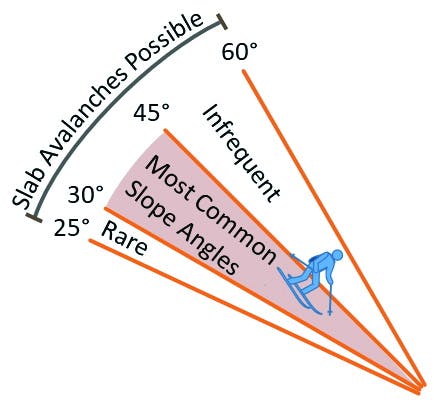
The incline of a slope is a significant factor in whether or not it can avalanche. Most avalanches occur on slopes that have an incline of 30-45 degrees ‒ about the steepness of a black diamond run at a ski hill, and favourite terrain for backcountry skiers and riders. However, avalanches can happen on slopes as flat as 25 degrees and as steep as 60 degrees. Below 25 degrees, slopes aren’t steep enough to avalanche and above 60 degrees, new snow sluffs frequently and slab avalanches are rare.
The following guidelines for using slope incline to predict avalanche size and frequency have been developed from experience.
- 60 to 90 degrees: Avalanches are rare; snow sluffs frequently in small amounts.
- 50 to 60 degrees: Frequent loose snow avalanches.
- 45 to 55 degrees: Frequent small slab avalanches.
- 30 to 45 degrees: Slab avalanches of all sizes.
- 25 to 30 degrees: Infrequent (often large) slab avalanches; wet loose avalanches.
- 10 to 25 degrees: Infrequent wet snow avalanches and slush flows.
A minimum slope angle is required to initiate a slab fracture, however, a fracture may propagate to a flatter slope after an initial failure on a steeper slope has occurred. Traveling on lower-angled terrain and minimizing exposure to steep slopes is an effective way to limit exposure to avalanche terrain.